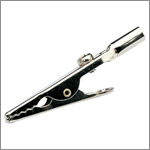TEST 5: Throttle Position (TP) Sensor 1 Resistance Test

OK, so far you have confirmed that Throttle Position (TP) Sensor 1:
- Is being fed with power (5 Volts) (TEST 2).
- Is being supplied with Ground (TEST 3).
- Is creating a TP Signal or is not creating one (TEST 4).
I know it sounds kind of confusing to tell you (in TEST 4) that whether you get a TP signal or not, you have to come and do this test, but for both test results you need to check TP Sensor 1 internally, with a resistance test.
Checking the internal resistance of Throttle Position Sensor 1 is very easy and best of all, this test will let you know conclusively if TP Sensor 1 is bad or not.
IMPORTANT: For the TP Sensor 1 resistance test to be accurate, you NEED to use an analog multimeter. If you don't have one, you can use a digital multimeter that has a bar graph in Ohms mode. This is important, because a digital multimeter that does not have a bar graph will not respond fast enough to the changes in throttle angle and will show gaps in the values (these gaps may lead you to believe the sensor is bad when it isn't).
OK, to get this pie baked, this is what you need to do:
STEP 1:

- Disconnect the electronic throttle body's electrical connector.
- NOTE: You can do this test with the throttle body off of the vehicle (this is what I do, since it's a whole lot easier to test it this way) or you can test it while it's on the vehicle.
- Locate pin H and pin G on the throttle body (see photo above).
- Connect the multimeter lead to these two pins using crocodile tip connectors (you can buy these at Radio Shack, see photo of crocodile tip).
- Measure the resistance of these 2 pins with your multimeter in Ohms mode.
- This test is done with the throttle plate at its rest position (closed).
- Do not apply any more pressure on the throttle plate to completely close it.
- Your multimeter should read about 4.2 K ohms.
STEP 2:
- Now, slowly open the throttle plate by hand till it reaches its maximum wide open throttle (WOT) position.
- As you open the throttle plate, the Ohms readings should decrease.
- If you're using an analog multimeter, the multimeter's needle should smoothly move up without any big jerky jumps.
- If you're using a digital multimeter with a bar graph, the bar graph should indicate a smooth increase in bars.
- At wide open throttle, your multimeter should register about 1.4 to 1.5 K Ohms.
STEP 3:
- Now, slowly close the throttle plate till it reaches its closed throttle position.
- As you close the throttle plate, the Ohms readings should increase.
- If you're using an analog multimeter, the multimeter's needle should smoothly move down without any big jerky jumps.
- If you're using a digital multimeter with a bar graph, the bar graph should indicate a smooth decrease in bars.
- Repeat steps 5 through 9 a couple of times, just to make sure you get the same results each time.
Let's interpret your test results:
CASE 1: The multimeter registered a smooth increase/decrease of the Ohms values as you opened/closed the throttle plate. This is the good and normal test result and let's you know that Throttle Position (TP) Sensor 1 is OK and not the cause of the issue (P0120 trouble code).
CASE 2: The multimeter DID NOT register an increase/decrease of the Ohms values as you opened/closed the throttle plate. This tells you that Throttle Position Sensor 1 is bad and is the root cause of the P0120: TP Sensor 1 Circuit Malfunction trouble code.
Since TP Sensor 1 is part of the electronic throttle body, you'll need to replace the entire thing.
NOTE: This test result is true ONLY if you are using an analog multimeter or a digital multimeter with a bar graph. Why? Because a digital multimeter without a bar graph will show gaps in the Ohm's numbers it's displaying, as you open and close the throttle plate AND this is normal. A digital multimeter with a bar graph works better, since its bar graph won't show any gaps (it's able to respond fast enough to the changes in throttle plate angle).

If this info saved the day, buy me a beer!

